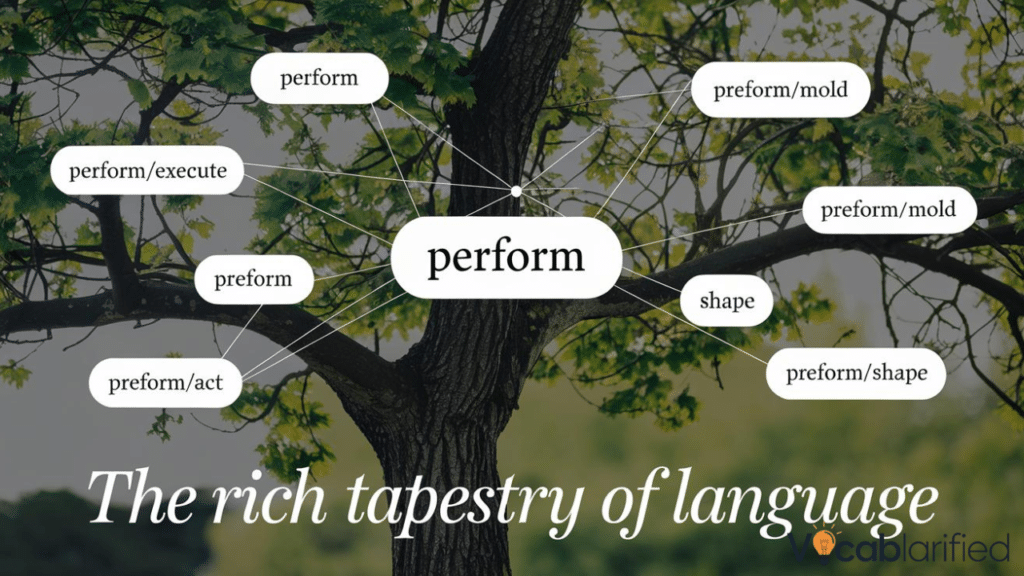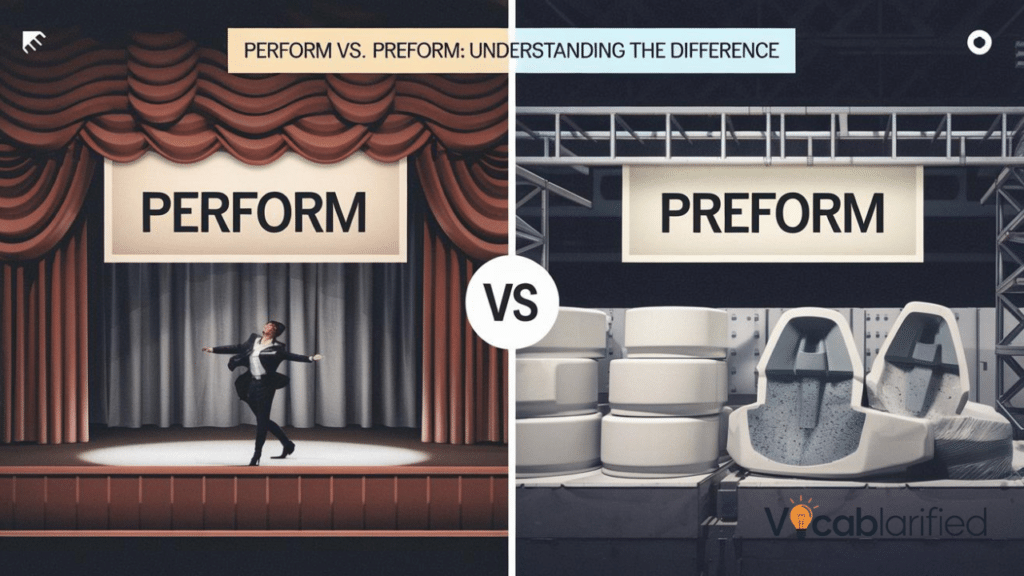In the vast landscape of the English language, words often bear striking similarities that can lead to confusion. Two such words that frequently perplex writers and speakers alike are “perform” and “preform.”
While they may look and sound similar, their meanings and applications differ significantly. This article delves into the nuances of these terms, exploring their definitions, usage contexts, and practical examples to help you navigate their differences with confidence.
The Essence of Perform
At its core, perform is a verb that embodies the act of carrying out or executing a task, action, or function. It’s a word that resonates with accomplishment and execution, often used in contexts ranging from everyday activities to professional endeavors and artistic expressions.
When we talk about performing, we’re referring to the act of bringing something into fruition through action. This could be as simple as performing daily chores or as complex as performing a symphonic masterpiece. The versatility of “perform” makes it a staple in our linguistic repertoire.

Preform: Shaping the Future
On the other hand, preform takes us into a different realm altogether. This term is primarily used as a noun or, less commonly, as a verb in specific technical contexts. As a noun, a preform is a premade form or mold used in manufacturing processes. When used as a verb, it refers to the act of shaping or forming something beforehand.

The concept of preforming is intrinsically linked to preparation and planning. It’s about creating a foundation or template that will guide future processes, especially in industrial and engineering applications.
You Might Also Like: Roll Call Or Role Call: What’s The Difference?
Contextual Clarity
Understanding the context in which these words are used is crucial for their correct application. Let’s explore some scenarios to illustrate the distinct usage of perform and preform.
In the realm of performing arts, an actor might receive an email from their director:
“Dear Emily,
I’m thrilled to inform you that you’ll be performing the lead role in our upcoming production of ‘Hamlet.’ Your ability to execute complex emotional scenes with nuance has truly impressed the entire casting team. We’re confident you’ll carry out this challenging role with the excellence we’ve come to expect from you.
Rehearsals begin next Monday. Please come prepared to perform Act I, Scene III.
Best regards, Director Johnson”
In this context, “perform” is used consistently to denote the act of presenting or executing a theatrical role. It’s about bringing a character to life on stage, accomplishing the task of storytelling through performance.
Now, let’s shift gears to a manufacturing scenario:
“Hello Team,
We’ve finalized the designs for our new product line of recyclable water bottles. The next step is to create the preforms for the injection molding process. These preforms will shape the future of our eco-friendly initiative.
Our engineering department has developed a new polymer blend that will allow us to preform the bottle shapes with 30% less material while maintaining durability. This innovation in manufacturing will significantly reduce our environmental impact.
Please review the attached specifications for the preform molds and provide your feedback by Friday.
Regards, Sarah Chen, Product Development Lead”
Here, “preform” is used both as a noun (the molds) and a verb (the act of shaping), highlighting its specific application in industrial processes.
You Might Also Like: Inter Vs. Intra: Understanding The Difference
The Art of Distinction
To further clarify the difference, let’s examine how these terms manifest in various fields:
In music, a violinist performs a concerto, executing each note with precision. The instrument they play, however, may have parts that were preformed in a factory, shaped to exact specifications before assembly.

In sports, athletes perform on the field, carrying out plays and strategies. Their protective gear often includes preformed components, molded to fit and protect specific body parts.
In the corporate world, employees perform tasks and projects, working to accomplish company goals. Meanwhile, in the IT department, developers might use preformed code templates to streamline their programming efforts.
Everyday Applications
The distinction between perform and preform extends into our daily lives in subtle ways. When you perform your morning routine, you’re executing a series of actions – brushing your teeth, making coffee, checking emails. Each of these actions might involve items that were preformed during their manufacturing process, from the bristles on your toothbrush to the filter in your coffee maker.
You Might Also Like: Priviledge Or Privilege: What Is The Correct Spelling?
The Impact of Usage
The correct usage of perform and preform is not just a matter of grammatical accuracy; it can significantly impact communication clarity. Using “perform” when you mean “preform” (or vice versa) can lead to misunderstandings, especially in professional or technical contexts.
Consider this email exchange in a dental office:
“Hi Dr. Martinez,
The new dental crowns we ordered have arrived. They’ve been preformed based on the patient’s dental impressions and are ready for final adjustments and placement.
Best, Dental Assistant Alex”
In this scenario, using “performed” instead of “preformed” would have completely changed the meaning, suggesting incorrectly that the final dental procedure had already taken place.
Mastering the Difference
To truly grasp the distinction between perform and preform, it’s helpful to associate them with their core concepts:
Perform = Action, Execution, Accomplishment Preform = Preparation, Shaping, Molding
By keeping these associations in mind, you can navigate their usage with greater confidence. Remember, we perform actions, but we preform materials or components.
The Role of Context
Context plays a pivotal role in determining whether perform or preform is the appropriate choice. In artistic or professional settings, perform is more likely to be the correct term. In manufacturing, engineering, or certain scientific fields, preform might be the word you’re looking for.

Common Mistakes and How to Avoid Them
One of the most common mistakes is using “preform” when “perform” is intended, often due to a simple typo or misunderstanding. To avoid this, always double-check your writing, especially in formal documents or important communications.
Another pitfall is assuming that “preform” can be used interchangeably with “perform” to sound more sophisticated. This is incorrect and can lead to confusion. Stick to “perform” for actions and tasks, reserving “preform” for its specific technical meanings.
The Evolution of Language
It’s interesting to note how the usage of perform and preform has evolved over time. While “perform” has been a staple of the English language for centuries, “preform” is a relatively newer term, gaining prominence with the advent of modern manufacturing techniques.
Practical Applications
To further illustrate the practical applications of perform and preform, let’s look at some industry-specific examples:
| Industry | Perform Usage | Preform Usage |
|---|---|---|
| Theater | Actors perform roles | Costume designers use preformed elements |
| Sports | Athletes perform in games | Equipment makers preform protective gear |
| Music | Musicians perform concerts | Instrument makers preform wooden components |
| Education | Students perform experiments | Teachers preform lesson plan templates |
| Healthcare | Surgeons perform operations | Medical device companies preform implants |
| Technology | Software performs functions | Hardware includes preformed circuit boards |
| Construction | Workers perform building tasks | Architects use preformed building components |
| Automotive | Cars perform on test tracks | Manufacturers preform body panels |
| Fashion | Models perform on runways | Designers preform fabric for structured garments |
| Culinary | Chefs perform cooking techniques | Food processors preform certain ingredients |
This table showcases how the terms are applied across various fields, emphasizing their distinct meanings and contexts.
The Linguistic Landscape
The English language is rich with words that share similarities yet carry distinct meanings. Perform and preform exemplify this linguistic phenomenon, challenging us to pay close attention to context and usage.
| Word Pair | Similarity | Key Difference |
|---|---|---|
| Perform/Preform | Both relate to action | Perform is about execution, Preform about preparation |
| Affect/Effect | Both relate to influence | Affect is typically a verb, Effect typically a noun |
| Complement/Compliment | Both positive in nature | Complement enhances, Compliment praises |
| Precede/Proceed | Both relate to order | Precede comes before, Proceed moves forward |
| Imply/Infer | Both about meaning | Imply suggests, Infer deduces |
| Assure/Ensure/Insure | All about certainty | Assure is to promise, Ensure to make certain, Insure to protect financially |
| Elicit/Illicit | Sound similar | Elicit means to draw out, Illicit means illegal |
| Eminent/Imminent | Both about prominence | Eminent means distinguished, Imminent means impending |
| Discreet/Discrete | Both about separation | Discreet means cautious, Discrete means separate |
| Principle/Principal | Both about importance | Principle is a rule, Principal is main or a school head |
This table highlights other word pairs that often cause confusion, providing a broader perspective on the intricacies of English vocabulary.

The Power of Precision
In conclusion, the difference between perform and preform may seem subtle at first glance, but it carries significant weight in communication. Whether you’re writing a professional email, crafting a technical report, or engaging in everyday conversation, choosing the right word can make all the difference.
Remember, we perform actions, tasks, and roles, bringing them to life through our efforts. We use preforms in manufacturing and engineering to shape and prepare materials for their final form. By understanding and applying these distinctions, you empower your communication with clarity and precision.
As you navigate the rich tapestry of the English language, let the nuances between perform and preform serve as a reminder of the importance of word choice. In the grand performance of communication, every word plays its part, shaped by context and intention, much like a carefully preformed component in a larger whole.

Emma Carter is an experienced blogger at Vocablarified. She enjoys helping people expand their vocabulary and improve their language skills. With a warm and approachable writing style, Emma makes learning new words fun and accessible. When she’s not writing, she loves reading books and discovering new phrases to share with her readers. Emma is passionate about making language learning an enjoyable journey for everyone.







